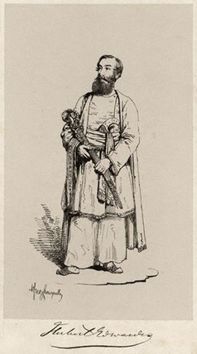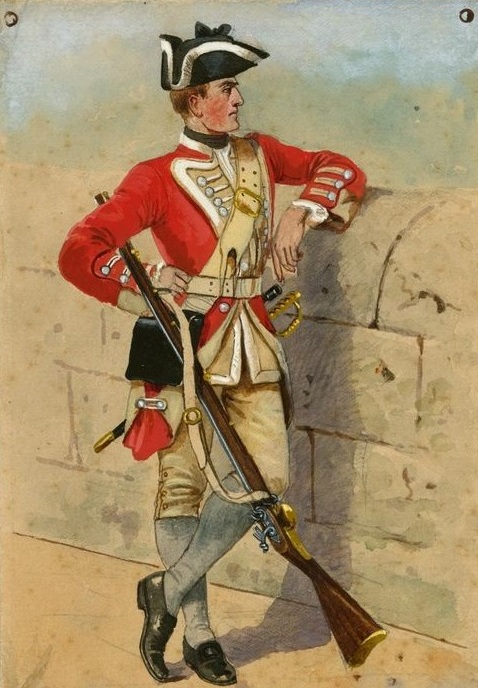|
Herbert Benjamin Edwardes
Major-General Sir Herbert Benjamin Edwardes DCL (12 November 1819 – 23 December 1868) was a British administrator, soldier, and statesman active in the Punjab region of British India. He is best known as the "Hero of Multan" for his pivotal role in securing British victory in the Second Anglo-Sikh War. Background and early life Edwardes was born at Frodesley in Shropshire on 12 November 1819, the 2nd son of the Rev. Benjamin Edwardes (1790/1-1823), rector of Frodesley, a younger son of Sir John Thomas Cholmondeley Edwardes, 8th Baronet, of Shrewsbury (1764–1816). The Edwardes Baronetcy of Shropshire had been conferred on his ancestor Sir Thomas Edwardes by King Charles I in 1644/5.The baronetcy eventually became dormant on the death of the 10th Baronet Sir Henry Hope Edwardes to extant with Edwardes-Iddon which Edwardes are descended claiming succession to the title. Edwardes's mother died during his infancy, and from the age of four, following his father's death in ... [...More Info...] [...Related Items...] OR: [Wikipedia] [Google] [Baidu] |
Highgate Cemetery
Highgate Cemetery is a place of burial in North London, England, designed by architect Stephen Geary. There are approximately 170,000 people buried in around 53,000 graves across the West and East sides. Highgate Cemetery is notable both for some of the people buried there as well as for its ''de facto'' status as a nature reserve. The Cemetery is designated Grade I on the Register of Historic Parks and Gardens. Location The cemetery is in Highgate N6, next to Waterlow Park, in the London Borough of Camden. It comprises two sides, on either side of Swain's Lane. The main gate is on Swain's Lane, just north of Oakshott Avenue. There is another, disused, gate on Chester Road. The nearest public transport (Transport for London) is the C11 bus, Brookfield Park stop, and Archway tube station. History and setting The cemetery in its original formthe northwestern wooded areaopened in 1839, as part of a plan to provide seven large, modern cemeteries, now known as the " Magnificent ... [...More Info...] [...Related Items...] OR: [Wikipedia] [Google] [Baidu] |
Charles I Of England
Charles I (19 November 1600 – 30 January 1649) was King of Kingdom of England, England, Kingdom of Scotland, Scotland, and Kingdom of Ireland, Ireland from 27 March 1625 until Execution of Charles I, his execution in 1649. Charles was born into the House of Stuart as the second son of King James VI of Scotland, but after his father inherited the English throne in 1603, he moved to England, where he spent much of the rest of his life. He became heir apparent to the kingdoms of England, Scotland, and Ireland in 1612 upon the death of his elder brother, Henry Frederick, Prince of Wales. An unsuccessful and unpopular attempt to marry him to Infanta Maria Anna of Spain culminated in an eight-month visit to Habsburg Spain, Spain in 1623 that demonstrated the futility of the marriage negotiation. Two years later, shortly after his accession, he married Henrietta Maria of France. After his accession in 1625, Charles quarrelled with the English Parliament, which sought to curb his ro ... [...More Info...] [...Related Items...] OR: [Wikipedia] [Google] [Baidu] |
Urdu
Urdu (; , , ) is an Indo-Aryan languages, Indo-Aryan language spoken chiefly in South Asia. It is the Languages of Pakistan, national language and ''lingua franca'' of Pakistan. In India, it is an Eighth Schedule to the Constitution of India, Eighth Schedule language, the status and cultural heritage of which are recognised by the Constitution of India. Quote: "The Eighth Schedule recognizes India's national languages as including the major regional languages as well as others, such as Sanskrit and Urdu, which contribute to India's cultural heritage. ... The original list of fourteen languages in the Eighth Schedule at the time of the adoption of the Constitution in 1949 has now grown to twenty-two." Quote: "As Mahapatra says: "It is generally believed that the significance for the Eighth Schedule lies in providing a list of languages from which Hindi is directed to draw the appropriate forms, style and expressions for its enrichment" ... Being recognized in the Constitution, ... [...More Info...] [...Related Items...] OR: [Wikipedia] [Google] [Baidu] |
Hindustani Language
Hindustani is an Indo-Aryan language spoken in North India and Pakistan as the lingua franca of the region. It is also spoken by the Deccani people, Deccani-speaking community in the Deccan plateau. Hindustani is a pluricentric language with two Standard language, standard Register (sociolinguistics), registers, known as Hindi (Sanskritisation (linguistics), Sanskritised register written in the Devanagari script) and Urdu (Persianization, Persianized and Arabization, Arabized register written in the Perso-Arabic script) which serve as official languages of India and Pakistan, respectively. Thus, it is also called Hindi–Urdu. Colloquial registers of the language fall on a spectrum between these standards. In modern times, a third variety of Hindustani with significant English influences has also appeared, which is sometimes called Hinglish or Urdish.Salwathura, A. N.Evolutionary development of ‘hinglish’language within the Indian sub-continent. ''International Journal ... [...More Info...] [...Related Items...] OR: [Wikipedia] [Google] [Baidu] |
Karnal
Karnal () is a city located in the state of Haryana, India and is the administrative headquarters of Karnal District. The city is well connected as it lies on National Highway 01, in the south of the city lies the cities of Panipat and Sonipat and in the north lies Kurukshetra and Yamunanagar city while in the east lies the river Yamuna, on the other end of which lies Saharanpur and Shamli district of Uttar Pradesh on the eastern bank. Karnal was used by the East India Company army as a refuge during the 1857 Mutiny, Indian Rebellion of 1857 in Delhi. The Battle of Karnal between Nader Shah of Persia and the Mughal Empire took place in this city in 1739. Etymology The city associates itself with the character Karna from the Indian epic Mahabharata. History Ancient At the end of 6th century A.D., the area was under the rule of the Vardhanas of Thanesar. The 7th century was a period of religious eclecticism, as Buddhism was declining and Hinduism was resurging in the Indo ... [...More Info...] [...Related Items...] OR: [Wikipedia] [Google] [Baidu] |
Danapur
Danapur Nizamat or Danapur is an Indian satellite town and one of six subdivisions (tehsil) in the Patna district of Bihar state.City Development Plan for Danapur 2014-03-05 The population was 182,241 at the 2011 India Census. It is part of the Patna Metropolitan Region. It was constituted as a municipality in 1887. Danapur is also a shelter and hatchery for the migrating Siberian cranes, locally called ''Janhgil''. They visit every year during the monsoon season for breeding and leave this place before the start of the winter season. The Sub-Area Headquarters of Bihar ... [...More Info...] [...Related Items...] OR: [Wikipedia] [Google] [Baidu] |
101st Regiment Of Foot (Royal Bengal Fusiliers)
The 101st Regiment of Foot (Royal Bengal Fusiliers) was an infantry regiment of the Bengal Army and British Army that existed from 1652 to 1881. The regiment was raised in India in 1652 by the East India Company as the company's first non-native infantry regiment. Over the following two centuries, the regiment was involved in nearly all of the East India Company's conflicts which consolidated British rule over India. The Royal Bengal Fusiliers was transferred to the command of the British Army in 1862 following the Indian Mutiny of 1857 and the end of Company rule in India. Under the Childers Reforms it amalgamated with the 104th Regiment of Foot (Bengal Fusiliers) to form the Royal Munster Fusiliers in 1881. History Formation and consolidation of British rule The regiment was raised by the East India Company as a Guard of Honour in 1652. The regiment was initially involved in guarding the East India Company's factories along the Hugli River in Bengal which was India's rich ... [...More Info...] [...Related Items...] OR: [Wikipedia] [Google] [Baidu] |
Calcutta
Kolkata, also known as Calcutta (List of renamed places in India#West Bengal, its official name until 2001), is the capital and largest city of the Indian States and union territories of India, state of West Bengal. It lies on the eastern bank of the Hooghly River, west of the border with Bangladesh. It is the primary Financial centre, financial and Commercial area, commercial centre of Eastern India, eastern and Northeast India, northeastern India. Kolkata is the list of cities in India by population, seventh most populous city in India with an estimated city proper population of 4.5 million (0.45 crore) while its metropolitan region Kolkata Metropolitan Area is the List of million-plus agglomerations in India, third most populous metropolitan region of India with a metro population of over 15 million (1.5 crore). Kolkata is regarded by many sources as the cultural capital of India and a historically and culturally significant city in the historic Bengal, region of ... [...More Info...] [...Related Items...] OR: [Wikipedia] [Google] [Baidu] |
Shrewsbury (UK Parliament Constituency)
Shrewsbury is a United Kingdom constituencies, parliamentary constituency in England, centred on the town of Shrewsbury in Shropshire. It has been represented in the House of Commons of the United Kingdom, House of Commons of the Parliament of the United Kingdom since 2024 United Kingdom general election, 2024 by Julia Buckley. A constituency for the town has existed since the 13th century; it was known as Shrewsbury and Atcham between 1983 and 2024. Boundaries 1918–1950: The Borough of Shrewsbury, and the Rural Districts of Atcham and Chirbury. 1950–1974: The Borough of Shrewsbury, and the Rural District of Atcham. 1974–2024: As prior but with redrawn boundaries. The constituency was coextensive with the Shrewsbury and Atcham, Borough of Shrewsbury and Atcham, which became the Central area committee, area of Shropshire Council after that council's formation. 2024–present * The County of Shropshire electoral divisions of: Abbey; Bagley; Battlefield; Bayston Hill, C ... [...More Info...] [...Related Items...] OR: [Wikipedia] [Google] [Baidu] |
Richard Jenkins (MP)
Sir Richard Jenkins (18 February 1785 – 30 December 1853) was member of parliament for Shrewsbury from 1830 to 1832 and from 1837 to 1841. He was also Chairman of the East India Company in 1839. Personal life Richard Jenkins was born at Cruckton, near Shrewsbury, the eldest son of Richard Jenkins of Bicton Hall, Shropshire. He married Elizabeth Helen, daughter of Hugh Spottiswoode, of the Honourable East India Company Civil Service, in 1824 and was the father of Colonel Richard Jenkins of the 1st Bengal Cavalry, two other sons and two daughters. Career Jenkins was at the Battle of Seetabuldee and also the capture of Nagpur. He served in the Bombay Civil Service from 1800 to 1828 and was the British Resident at Nagpur from 1807 to 1827. He was an East India Company Director from 1832 to 1853. Honours Sir Richard was invested as a Knight Grand Cross of the Order of the Bath (GCB) in 1838, and awarded the Third Mahratta War medal. He was elected a Fellow of the Royal Geogra ... [...More Info...] [...Related Items...] OR: [Wikipedia] [Google] [Baidu] |
University Of Oxford
The University of Oxford is a collegiate university, collegiate research university in Oxford, England. There is evidence of teaching as early as 1096, making it the oldest university in the English-speaking world and the List of oldest universities in continuous operation, second-oldest continuously operating university globally. It expanded rapidly from 1167, when Henry II of England, Henry II prohibited English students from attending the University of Paris. When disputes erupted between students and the Oxford townspeople, some Oxford academics fled northeast to Cambridge, where they established the University of Cambridge in 1209. The two English Ancient university, ancient universities share many common features and are jointly referred to as ''Oxbridge''. The University of Oxford comprises 43 constituent colleges, consisting of 36 Colleges of the University of Oxford, semi-autonomous colleges, four permanent private halls and three societies (colleges that are depar ... [...More Info...] [...Related Items...] OR: [Wikipedia] [Google] [Baidu] |







